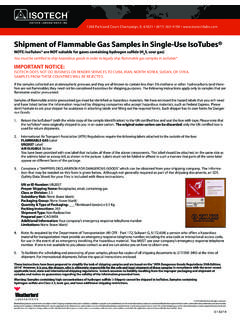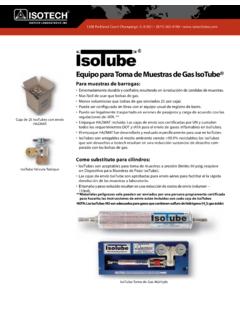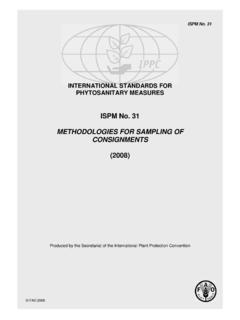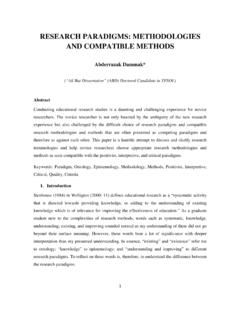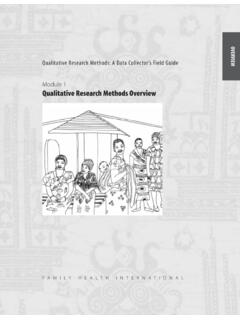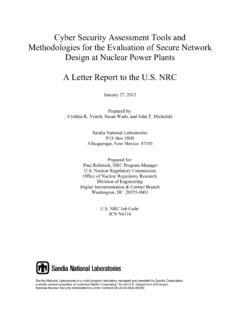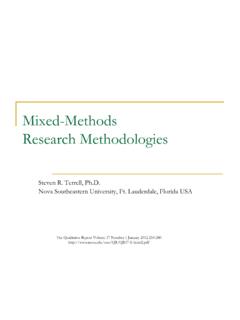Transcription of Effect of Different Sampling Methodologies on Measured ...
1 Effect of Different Sampling Methodologieson Measured methane concentrations inGroundwater Samplesby Lisa J. Molofsky1, Stephen D. Richardson2, Anthony W. Gorody3, Fred Baldassare4, June A. Black5,Thomas E. McHugh6, and John A. Connor6 AbstractAnalysis of dissolved light hydrocarbon gas concentrations (primarily methane and ethane) in water supply wells is commonlyused to establish conditions before and after drilling in areas of shale gas and oil extraction. Several methods are currently usedto collect samples for dissolved gas analysis from water supply wells; however, the reliability of results obtained from thesemethods has not been quantified.
2 This study compares dissolved methane and ethane concentrations Measured in groundwatersamples collected using three Sampling methods employed in pre- and post-drill Sampling programs in the Appalachian Basin. Theseinclude an open-system collection method where 40 mL volatile organic analysis (VOA) vials are filled directly while in contactwith the atmosphere (Direct-Fill VOA) and two alternative methods: (1) a semi-closed system method whereby 40 mL VOA vialsare filled while inverted under a head of water (Inverted VOA) and (2) a relatively new (2013) closed system method in which thesample is collected without direct contact with purge water or the atmosphere (IsoFlask ).
3 This study reveals that, in the absenceof effervescence, the difference in methane concentrations between the three Sampling methods was relatively small. However,when methane concentrations equaled or exceeded 20 mg/L (the approximate concentration at which effervescence occurs in thestudy area), IsoFlask (closed system) samples yielded significantly higher methane concentrations than Direct-Fill VOA (opensystem) samples, and Inverted VOA (semi-closed system) samples yielded lower concentrations . These results suggest that open andsemi-closed system sample collection methods are adequate for non-effervescing samples.
4 However, the use of a closed systemcollection method provides the most accurate means for the measurement of dissolved hydrocarbon gases under all the last decade, tens of thousands of sampleshave been collected from water supply wells by oiland gas operators to establish baseline dissolved hydro-carbon gas concentrations ( , primarily methane , but1 Corresponding author: GSI Environmental Inc., 2211 NorfolkSt., Suite 1000, Houston, TX 77098; (713) 522-6300; fax: (713)522-8010; Environmental Inc., Austin, TX Geoscience Consulting, Inc., Houston, TX Applied Geosciences, Murrysville, PA Department of Environmental Protection,Harrisburg, PA Environmental Inc.)
5 , Houston, TX impact statement:Sample collection method canhave a significant Effect on Measured dissolved hydrocarbon August 2015, accepted February 2016. 2016 The by Wiley Periodi-cals, is an open access article under the terms of the CreativeCommons Attribution-NonCommercial License, which permits use,distribution and reproduction in any medium, provided the originalwork is properly cited and is not used for commercial : ethane and propane) and to evaluate the presence orabsence of impacts after drilling in areas of unconven-tional oil and gas extraction ( , Molofsky et al.
6 2013;Siegel et al. 2015). Such samples are almost exclusivelycollected at the surface from a tap or faucet becauseinternal access to the downhole portion of the well iseither impractical ( , the wellhead is not accessible orthe presence of a drop-pipe and permanent submersiblepump obstructs access to the wellbore) or because thepotential for damaging the well and its contents presents aliability. A number of Different sample collection methodshave been employed to collect dissolved hydrocarbon gassamples at the surface. However, these methods have notbeen systematically evaluated to determine the accuracy,precision, and comparability of results obtained usingdifferent collection of dissolved light hydrocarbongas samples at the surface can be complicated byeffervescence (bubble formation), which occurs whengroundwater is supersaturated with dissolved gases.
7 Atdepth within the aquifer and water supply well, methaneconcentrations above its solubility limit at the surfacecan be sustained because the hydrostatic head pressure greater than one atmosphere. However, asthe sample is pumped to the surface, the reduction inpressure decreases the amount of methane that can bemaintained in solution, resulting in methane was the only gas present in groundwater ,effervescence at the surface would occur at the saturationconcentration of methane ( 25 to 35 mg/L, dependingon water temperature and elevation). However, methanecommonly occurs with carbon dioxide and other gases,which also exert gas pressure in groundwater .
8 Forexample, methanogenesis produces equal molar concen-trations of methane and carbon dioxide (Drever 1988).As a result, effervescence can occur before any one gasreaches its individual saturation concentration ( , atmethane concentrations below 25 to 35 mg/L).Commonly used protocols for collection of dissolvedhydrocarbon gas samples have been adapted from theprotocols for volatile organic compounds (VOCs) ( ,BTEX), which are generally more soluble and less volatilethan gaseous hydrocarbons (Sander 1999). For manyVOCs, concentrations of regulatory concern ( , con-centrations considered to potentially pose a risk to humanhealth and/or the environment, with a margin of safety)are several orders of magnitude below the solubilitylimits (Pankow and Cherry 1996; Moran 2006; Cwiertnyand Sherer 2010).
9 In contrast, methane is nontoxic;however, it is a potential asphyxiation and explosionhazard. Therefore, methane is of the greatest concernunder conditions at which exsolution could result in anoxygen-deficient or explosive atmosphere (Eltschlageret al. 2001). Thus, the accurate measurement of methanein these samples is critical to support appropriate decisionmaking on the need for potential principle, the use of an open system for samplecollection may allow dissolved gases to escape to theatmosphere, whereas a closed system traps all gases,both dissolved and effervescing.
10 The potential for lowbias associated with open systems is well recognized(Beyerle et al. 2000); however, the most common closed-system method utilized historically to collect samples atthe surface ( , the copper tube method; Beyerle et ) can be challenging to implement, and commerciallaboratories are not typically equipped to process thesesamples. As a result, open-system collection methodscontinue to be widely , most oil and gas operators in theAppalachian Basin collect groundwater samples fordissolved hydrocarbon gas analysis using an open-systemcollection method, in which the samplers fill 40 mL glassvolatile organic analysis (VOA) vials directly from tubingor a tap at the surface ( , Direct-Fill VOA method).


